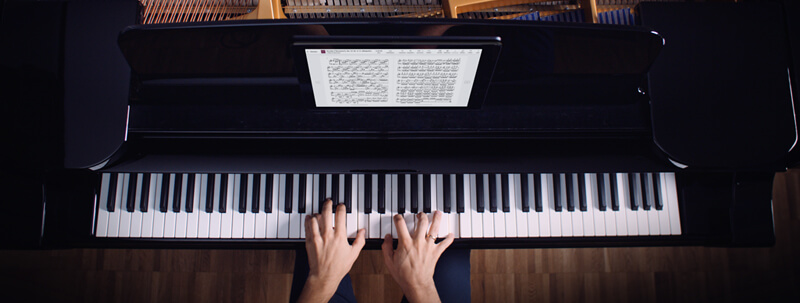How to Play the F minor Scale on the Piano - Scales, Chords & Exercises

Jump to section
You get a fascinating chord poster + exclusive content!
The Notes of the F minor Scale
The F minor scale starts on F and includes four flat notes, Ab, Bb, Db, and Eb. It uses the pitches F-G-Ab-Bb-C-Db-Eb-F. On the piano, you need to play four black keys and three white ones.

How to Play the F minor Scale With the Right Hand (Treble Clef)
On the piano, you can play the F minor scale going up (toward the higher notes), or coming down. In the treble clef, do this:
- Play the following notes going up: F-G-Ab-Bb-C-Db-Eb-F. Start playing on F with your first finger, and tuck your thumb after you have played the fourth (!) note, the Bb, to reach the C. As you continue playing, you will play the Db comfortably with your second (index) finger before the Eb with your third finger - and finish on F with your fourth.
- Play the following notes going down: F-Eb-Db-C-Bb-Ab-G-F. Start playing with your fourth finger and play down to C, then tuck your fourth finger over the thumb to play the Bb, and continue until your first finger reaches the F.

How to Play the F minor Scale With the Left Hand (Bass Clef)
Piano beginners may find it difficult to read and play the left hand. It is worth investing some time to really familiarize yourself with the notes of the F minor scale in the bass clef, and learn how to read them in music scores.
The notes are the same as in the right hand (F-G-Ab-Bb-C-Db-Eb-F), but they look different:

How to play F minor with the left hand
- Going up: Starting with your fifth finger (the pinkie) on F, play the full hand up to C, then tuck your third finger over the thumb to reach the Db. Then continue playing to reach the high F.
- Coming down: Start with your first finger. After the first three notes, when you have reached the Db, tuck your thumb under to reach the C, then play the full hand back down to F.
The F minor Key Signature
The key signature, located at the beginning of each line of a piece, lets you see which notes will be raised (#) or lowered (b) consistently throughout that piece.
If you spot this key signature below, the piece is likely in F minor (or in its parallel scale Ab-Major you'll be able to determine that from the "minor" or "major" mood of the piece):

6 Exercises to Practice the F minor Scale
Play one exercise after the other and only move on after having correctly played the previous exercise 5 times on your piano:
- Play the left hand up and down using a metronome and slowly increasing speed
- Play the right hand up and down using a metronome and slowly increasing speed
- Play both hands up and down using a metronome and slowly increasing speed
- Play the left hand up starting from the lowest F to the highest, and down starting from the highest F to the lowest
- Play the right hand up starting from the lowest F to the highest, and down starting from the highest F to the lowest
- Play both hands up starting with the left hand on the lowest F and stopping when the right hand reaches the highest F, then play down to the starting position
Why you should exercise scales in general:
- To memorize a scale
- To practice dexterity and intonation (play all keys with even loudness. Beginners often play the notes they work with their stronger fingers much harder. Aim for an even tone)
- To be able to play the scale in time without hesitating to find your fingerings
- To be able to build chords and improvise
F minor Chords on the Piano
A minor chord is constructed of three or more notes: The root note - the minor third - the perfect fifth.
In short, this tells us about F minor:
- The basic F minor chord consists of F-Ab-C.
- The first inversion is Ab-C-F.
- The second inversion is C-F-Ab.
To practice the F minor chord and inversions, switch from the chord starting with the root note to the first, and the second inversion, starting slowly using a metronome, then increasing your tempo.
10 beautiful pieces in F minor
- 1 Gnossienne No. 1: Erik Satie
- 2 All Of Me: John Legend
- 3 Children: Robert Miles
- 4 Truman Sleeps: Philip Glass
- 5 Paint It, Black: The Rolling Stones
- 6 Twist In My Sobriety: Tanita Tikaram
- 7 Hello: Adele
- 8 L’Inverno – Winter, Op. 8, RV 297: 1. Allegro non molto: Antonio Vivaldi
- 9 Just The Two Of Us: Grover Washington Jr.
- 10 What Could Have Been: Sting


